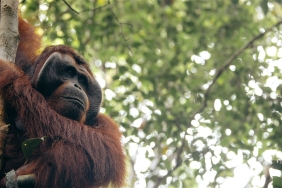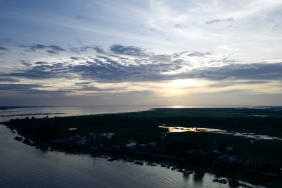PROBOSCIS MONKEYS, DISPLACED AND DISPLACED FROM THEIR OWN HOME
By: Nur Arinta
Proboscis monkeys are primates endemic to Borneo that live in riverside ecosystems, especially in the estuaries, with some occupying habitats as far as 60 to 300 kilometers inland. It is also often known as the Dutch monkey, due to its distinctive large elongated nose. Males have a larger nose than females. This nose is thought to have a function for males to attract females during mating season.
The monkey with the Latin name Nasalis larvatus is a diurnal animal, meaning that they move from sunrise to before sunset. According to experts, the usual activities of proboscis monkeys are looking for food, drinking, socializing with members of the colony, raising children, and looking for lice on the bodies of their friends. At night, the proboscis monkey will sleep until sunrise the next day. This endemic Borneo monkey is an arboreal species that spends most of its life in the tree canopy. However, if forced to, proboscis monkeys are often found descending to ground level in search of food or water, while crawling to their resting tree or to other food trees.
Proboscis monkeys are very sensitive and difficult to adapt to. They favor natural habitats that are undisturbed by humans. They are commonly found in a wide habitat typology, namely mangrove forests, gelam swamps, rubber forests, and Dipterocarpaceae forests.
Not only proboscis monkeys, but many humans also live in areas that are the habitat of proboscis monkeys. People who live around the forest need things like food, clothing, and shelter. They utilize the resources found in the forest, causing forest degradation without considering the interests of other living things. This clash of interests between humans is what causes conflicts to occur between the two, where the winner is always humans. The forest that is the habitat of the Proboscis Monkey is getting narrower and more controlled by humans. Moreover, the community considers that proboscis monkeys do not provide any benefits, both in social and economic aspects. This makes the Proboscis Monkey increasingly displaced and displaced in its own habitat.< br />
Not only does the narrowing of habitat threaten the life of the Proboscis Monkey, but this large-nosed monkey is also widely hunted by the community. Proboscis monkey experts say that the Proboscis Monkey population in all conservation areas in 1990 was estimated at five thousand individuals. Now the population in these areas has fallen sharply to 50 percent.
In unfavorable environmental conditions in their habitat, proboscis monkeys try to adapt to the various threats they face. Unfortunately, if the pressures faced exceed its adaptability, it is not impossible that this monkey, which can only be found in Kalimantan, will experience local extinction. Meijaard and Nijman said that the proboscis monkey colony on Pulau Kaget in the Barito River Estuary has experienced local extinction due to the conversion of its habitat into agricultural land.< br />
Adaptation is a very important process, because it determines the sustainability of the Proboscis Monkey. The increasing intensity of pressure experienced on the Proboscis Monkey and its habitat makes it increasingly difficult for the Proboscis Monkey to adapt. Currently the Proboscis Monkey population is scattered in narrow pockets of habitat. Their lives are becoming less prosperous, stressed, and increasingly vulnerable to extinction.
Along with the increasing threat, international conservation organizations also pay attention to this primate that is characterized by its large nose. The IUCN has categorized the proboscis monkey as Endangered (EN). While in CITES, the Proboscis Monkey is included in the Appendix I category, which means that this is a protected species and cannot be killed, and traded.
Not only in the international realm, the status of the Proboscis Monkey is also protected in Indonesian national law, namely in Law Number 5 of 1990 concerning Conservation of Natural Resources and Ecosystems, as well as in PP Number 7 of 1999 concerning Preservation of Plant and Animal Species. The regulations state that proboscis monkeys are a protected species and are prohibited from being harmed, killed or traded. If a violation occurs, the perpetrator will be subject to a maximum of five years imprisonment, and a maximum fine of IDR 100 million.
We need to pay attention to the preservation of proboscis monkeys. The rescue of proboscis monkeys needs to be carried out and supported by every stakeholder. One of the efforts made is to encourage and support ecotourism activities based on the protection of this endemic Bornean monkey. In addition, we can also become supervisors in the existing proboscis monkey conservation program. If we find the practice of hunting proboscis monkeys, we can report it to the local BKSDA, or through reporting applications that can be accessed on our smartphones, such as e-Protected Animal Reporting, the GAKKUM application, or the Wildscan application. By doing so, we contribute to the conservation of the proboscis monkey and protect it from extinction.





